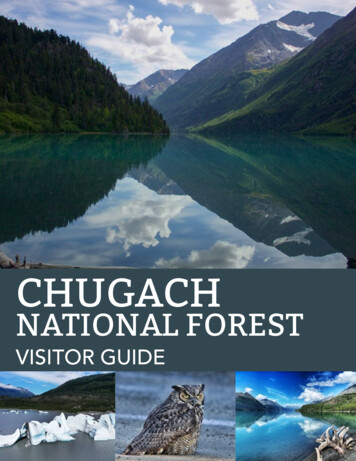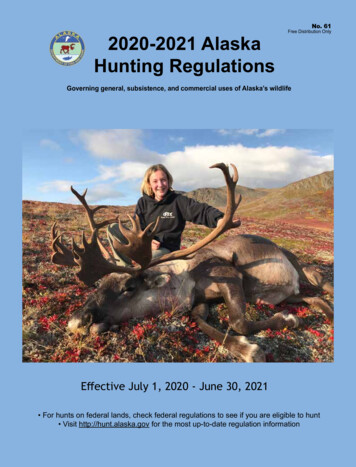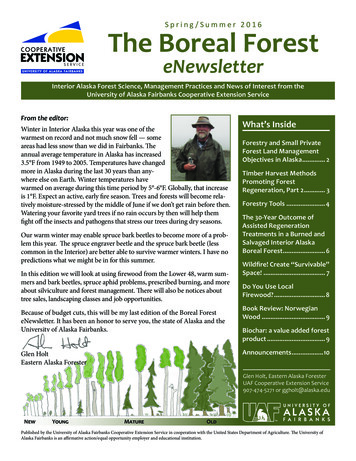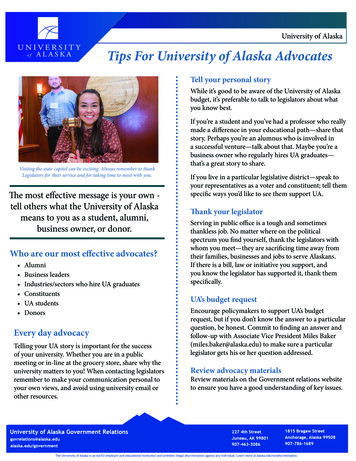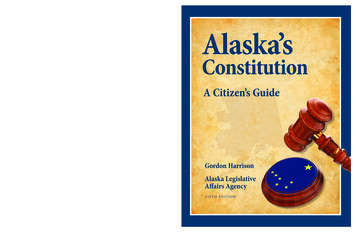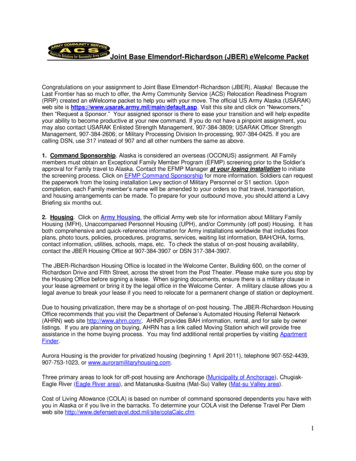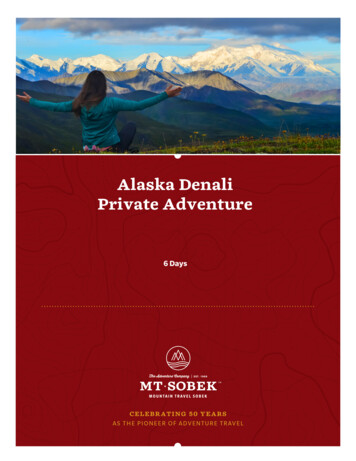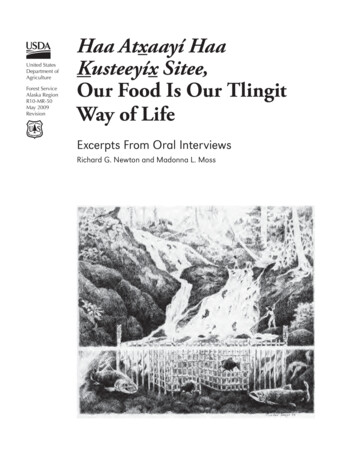
Transcription
United StatesDepartment ofAgricultureForest ServiceAlaska RegionR10-MR-50May 2009RevisionHaa Atxaayí HaaKusteeyíx Sitee,Our Food Is Our TlingitWay of LifeExcerpts From Oral InterviewsRichard G. Newton and Madonna L. Moss
l!nited StatesDepartment ofAgricultureForestServiceP.O. Box 21628Juneau, AK 99802-1628Alaska RegionFile Code: 1630Date: April 22, 2009Dear Reader:Haa At:s aayi Haa K usteeyi:s. Sitee. Our Food is Our Tlingit Way of Life is a remarkable publication both incontent and in its ability to inspire partnerships. The publication reflects the essential aspects of the livingculture of the Tlingits of Southeast Alaska. The Tlingit Elders who contributed to the originalpublication, and the Elders who guided the revision, preserved this information so that future generationswould be able to embrace lwa Lingit.!5.usteeyi:s., our Tlingit culture. Our newest partner, the Bureau ofIndian Affairs (BIA) assisted in funding the May 2009 reprint. I would like to thank Regional DirectorNiles Cesar and Natural Resource Manager Keith Kahklen.The commitment to document the "putting up of food" was conceived in 1978 by Tlingit cultural leadersattending a meeting in Sitka. Between 1979 and 1981, Forest Service Tlingit Historian Richard "Dick"Newton and Archaeologist Madonna Moss interviewed twenty-three Tlingit Elders. Dick Newtontranslated and transcribed his interviews into English, and he and Madonna compiled the originalmanuscript, The Subsistence Lifeway o f the Tlingit People: Exce1pts o f Oral Interviews, printed in 1984.Using a culturally relevant process led by Tlingit Elders, Joanne Wiita, Donald Bremner and LillianPetershoare produced Haa At:s aayi Haa K.usteeyi:s. Sitee, Our Food is Our Tlingit Way o.fLi(e, in 2005.The revision featured a culturally relevant title; the replacement of the word "subsistence," in manyinstances, with the phrase haa at:s aayi, "our food;" updated Tlingit spellings; the use of Tlingit placenames; a rewritten section "Perspectives on the Homeland of the Tlingit" to reflect the vibrancy of Tlingitculture; and the creation of an audio CD, Pronunciation o,(Tlingit Terms, the terms listed in Appendix III,Tlingit Tenninology. The revision also featured a letter by Myrna Newton Allen, daughter to DickNewton, which provides insight into her father's passion for documenting Tlingit history; and awonderfully reflective preface by co-author Madonna Moss honoring Dick and the Tlingit Elders whocontributed to the original publication.In 2006, the Southeast Alaska Inter-Tribal Fish and Wildlife Commission, the University of AlaskaSoutheast, and the Forest Service partnered to preserve the tape recorded interviews onto archival goldCDs. The CD collection, Voices ofHaa At:s.aayi Haa K usteeyi:s. Sitee is available at the UAS EganLibrary and at the University of Alaska Fairbanks, Oral History Program.G11rwlc/1eesh, thank you, to the BIA and to all the partners who assisted us in making this publication andthe related recordings available to the public. As you read about the traditional foods and culture of theTlingit, I hope you will be inspired to reflect upon the core traditions that sustain and enrich your life.Sincerely,DENNIS E. BSCHORRegional ForesterUSDA----,.Caring for the Land and Serving PeoplePrinted on Recycled Paper\i4rThe drawings on the cover and title page are reproductions from an original pen and ink drawing by Angoon artist JoAnn Georgeentitled "Salmon Fishing." It was inspired by a description ofa Tlingit fish trap near "Raven's Tidal Current" also known as "The Falls"that leads from Mitchell Bay to Salt Lake near Angoon, recorded by Frederica de Laguna (1960). A Jew hundred wood stake fishingweirs and traps have since been found preserved in the mudflats ofSoutheast Alaska. Archaeologists have radiocarbon-dated about 50 ofthese fishing sites, which we now know range in age from 4, 000 years old to the 20'h century. ]oAnn graciously consented to the use ofherdrawingfor the cover.
To the regal ancestors of my proud heritage I dedicate this book, for through them havecome the values I treasure.More specifically I dedicate it to my paternal grandfather, Timothy Newton, referred toby John Jackson.1 To my mother, Annie Newton, to whom Timothy taught values of subsistence living and who in turn, taught me. How well I remember her saying, “For supperwe are going to have our own Tlingit food! It is good for our system. Unless I have it nowand then, I am always feeling hungry.”This is simply my way of saying “thank you” for the work that went into my training andthe opportunity given me by the Forest Service to be one of the early contributors onthis subject.Richard G. Newton, Fall, 1983Photo courtesy of Myrna Allen and Ann Puffer¹ John C. Jackson tape-recorded interview,Tape 4.
February 3, 2005Dear Reader,One of the many endearing memories I have of my childhood is observing the love my Dad had for hisculture. Long before he began working for the Forest Service, I can remember many a time enteringour home to find Dad with such attentiveness, sitting near a visiting Tlingit elder, listening to whathe or she had to say. Dad would have a tape recorder running so he could more permanently recordvarious legends, teachings and the wisdom the elder shared with him that day. I could hear him askquestions now and then and though I couldn’t understand the Tlingit language, I knew history wasbeing recorded in a very special way.Dad was able to enjoy his Tlingit heritage through his constant connections with dear family membersand Native friends. He would visit with them every opportunity he could, making sure they knew ourdoor was always open to them. Those were treasured times!When the Forest Service approached Dad about becoming a Native Historian and putting togethera booklet about a portion of our Native history, Dad was excited to be a part of it. He knew this wasinformation that would be lost if it wasn’t recorded somehow for future generations. It was a verysatisfying feeling for him when the booklet was published in 1984 and made available for the generalpublic.I have recently had the opportunity to review the most recent revision of this booklet, now entitled“Haa Atxaayí Haa Kusteeyíx Sitee, Our Food Is Our Tlingit Way of Life.” The changes made to thebooklet have been updated and include a CD with pronunciations of over 150 Tlingit words. The valuable information contained in the original publication remains intact. The many people who made thisnew version possible are to be applauded for their excellent attention to detail and protocol.Without a doubt, I like to think of Dad “looking down” with pride at the sensitivity and accomplishment of a vision that comes with this latest publication. This information contained in the booklet istruly valued. I believe he would say “A job well done. Gunalchéesh!”A sincere thank you to all those who made this latest publication possible. May you, as the reader, beenlightened as you enjoy the history recorded through the sharing of the many elders that were interviewed. May we always have a hunger to learn more and grow as individuals through the contributionof the wisdom of our elders.Gunalchéesh,Myrna Newton Allen
Haa Atxaayí Haa Kusteeyíx Sitee,Our Food IsOur Tlingit Way of LifeExcerpts of Oral InterviewsRichard G. Newton and Madonna L. Moss
Table of ContentsLetter from Dennis E. Bschor .inside front coverForeword . iiLetter from John Sandor . iiiPrefaces .ivPreface by Richard G. Newton .ivPreface by Madonna L. Moss.vAcknowledgements to the First Edition . viiAcknowledgements to the Third Edition. viiiIntroduction . 1Traditions of the Tlingit Atxaayí Lifeway. 2Native Foods, Gifts of Season, Gifts of Place . 5Fish.5Game . 15Beach Food.20Wild and Cultivated Plants.23Responsibilities of the Tlingit Atxaayí Lifeway . 32Perspectives on the Homeland of the Tlingit . 35Afterword . 38Voices. 38Appendix I: List of Taped Interviews . 39Appendix II: Nutritional Values . 40Appendix III: Tlingit Terminology . 44Suggested Reading . 49Pronunciation of Tlingit Terms CD . inside back coverOur Food Is Our Tlingit Way of Lifei
ForewordThe Forest Service recognizes the value of the Tlingit knowledge regardingthe land and resources it manages. To increase its awareness and sensitivityto this knowledge, Richard Newton served as a Native Historian for theForest Service during 1979. Dick had recently retired after many years withthe Regional Office in Juneau. His own personal knowledge of his heritage,and his relationship with the elders in some of the outlying communitiesmade him an ideal person for the job.Dick’s assignment was to gather information about subsistence food. Therewas no formal plan of research, no tightly structured format to follow. Dickwent to some of the villages and spoke with the elders in the Tlingit language. He taped and later translated and transcribed the interviews. Theinterviews cover many topics, including some not directly related to haaatxaayí. In the typical Tlingit way, hard technical data are interwoven withsubtleties of the Native worldview. What you will find in this book is asmall portion of the total wealth contained in the transcriptions.This book is not a comprehensive study of Tlingit subsistence living. Thereare obvious gaps in the information presented herein. Our intent is to follow through with Dick’s objective—to help preserve a rapidly vanishingpart of Tlingit history. Knowledge of the Tlingit subsistence lifeway canhelp us to understand the Native perspective and can enhance all of ourlives. Dick Newton, Lgeik'i Éesh, took it upon himself to cast the nets, andit is our turn to share his impressive catch.Madonna L. Moss, 1983iiHaa Atxaayí Haa Kusteeyíx Sitee
Letter fromJohn SandorUnited StatesDepartment ofAgricultureForestServiceP.O. Box 1628Juneau, AK 99802Alaska RegionReply to:Date:1600July 24, 1984Dear Reader:The Subsistence Lifeway of the Tlingit People: Excerpts of Oral Interviews,represents the work of many people, but if one person were to be singled out,it is Richard Newton. The project was originally conceived during a meetingof cultural leaders in Sitka, six years ago. They recognized the wealth ofinformation on subsistence which should be preserved for the future.Dick wanted.to preserve the subsistence information that many elderly Tlingitpeople possessed. He began a series of interviews in 1978 collectinginformation from knowledgeable Tlingit elders throughout Southeast Alaska. Atthe same time, Madonna Moss, a young archaeologist working for the ForestService with a keen interest in Tlingit culture also interviewed severalpeople.Dick Newton translated and transcribed his interviews into English. He alsocollected other information on subsistence foods. Madonna working with Dicktook the transcripts and. extracted relevant-- materials and compiled thismanuscript.This c publication is a. legacy of Dick Newton Is dedication to the Tlingitculture. The original interview tapes and transcripts contain a wealth ofadditional information which is dso preserved for the future. They are onfile with the Forest Service offices in Juneau and the Rasmusen Library at theUniver-sity of Alaska, Fairbanks.I offer my sincere thanks to Dick and Madonna for enabling the Forest Serviceto present this invaluable information on Tlingit subsistence to others. ""Sincerely,Regional ForesterOur Food Is Our Tlingit Way of Lifeiii
PrefacesPreface byRichard G. Newton,1983Much has been said about subsistence since the Alaska Native ClaimsSettlement Act was passed in 1971. Each Eskimo, Aleut, Tlingit, andAthapascan village expresses the subsistence lifestyle in a unique way. Eachcontributes to the diversity and strength of our Alaskan heritage.Congressmen from Washington, Alaska State legislators, and state and federal officials have jobs to do and jobs to keep. Newcomers from the “lower48” demand their share and pack home their souvenirs of smoked salmon.Urban residents feel threatened that they will not be able to fish and huntfreely. Of course, it makes economic sense to supplement one’s income byputting up fish, meat, and berries. But that is not subsistence living as wehave known it in the past.According to Webster’s Collegiate Dictionary, subsistence is the minimumfood or shelter to support life. Tlingit people have learned how to survive the weather and keep body and soul together. We have special regardfor the fish and other animals we use for food. We know and respect theweather and the waters. Fish streams, hunting grounds, and berry patcheswere more than a means of filling our “minimum daily requirements.” Forus subsistence food is a tangible link with the past, with a way of life thatis quickly fading.In transition to the modern day, laws required children to attend school.This was good, and encouraged children to learn things about the world.But parents could not take children out of school, and attendance at traditional “places of higher learning”—the bays and fish streams and mountains—was limited to summer vacations. At school, and in the larger townsand cities, the younger Tlingit began to partake in Western ways and in thecash economy. More money was needed to survive, more money than onecould make living in the villages.Nowadays, young people are trying to remember the words of their grandparents. They are learning our subsistence ways. The interest in our traditions is growing not only because Indian food tastes good. It is because it isone of the only ways our culture can survive.Figure 1. Dick Newton. Photo courtesy of Myrna Allen.ivHaa Atxaayí Haa Kusteeyíx Sitee
When I was asked by the Forest Service to write a new preface for TheSubsistence Lifeway, I was initially flattered to hear that a new edition wouldsoon be available. Then I reflected upon how old their request made mefeel, since the first edition was completed over 20 years ago. When I startedto work with Dick Newton on this project in 1979, I was 25 years old andmany of the elders with whom we worked were the age of my own grandparents. At that time, Dick certainly did not consider himself an elder; hewas in his late 60s. In 2004, most of these tradition bearers and culturalexperts, as well as my own grandparents, have passed on. Dick Newtonhimself died in 1999. My last surviving grandparent, my maternal grandmother, Kathryn Reardon, was born in 1899 and died just a few days before September 11, 2001. How the world has changed since most of thesebeloved elders lived their lives.Preface byMadonna L. Moss,2004I feel enormously privileged to have had the opportunity to work with DickNewton and this group of Tlingit authorities on traditional environmentalknowledge. Although Dick had already conducted many of the interviewsbefore I joined the effort, I came to know these folks as individuals bylistening to their tapes, preparing transcriptions, and conducting some interviews myself. I also was involved in meeting with most of our contributors when Dick and I obtained releases from them to publish their material and agreement that the tapes and transcriptions would be archived atthe University of Alaska, Fairbanks, Oral History Department, Elmer E.Rasmuson Library. These people showed us great generosity, welcomingus into their homes for conversation, often accompanied by a fire in thestove and cups of coffee. In the years since, I have heard from friends thatthe tapes and transcriptions in Fairbanks have been used by several of thedescendants of these elders. This suggests that some of the project’s originalgoals have been achieved.I lived in Southeast Alaska from 1978 to 1983. After then, I transferred withthe Forest Service to Oregon, so that my then–fiancé, Jon Erlandson, and Icould both work in archaeology. Shortly thereafter, I transferred again withthe Forest Service when Jon and I married and moved to Seattle. In Seattle,I was able to take leave during the summers to spend time in Angoon,where I completed the field research for my Ph.D. dissertation. This workfocused on the archaeology of the Angoon Tlingit and documented thesubsistence lifeway into ancient times. The oldest site we studied in theAngoon area was a 3,200–year–old fishing weir used to catch salmon, discovered by our dear friend and Angoon resident, Gabriel George. I finishedmy dissertation in 1989, and Jon and I taught for a year at the University ofAlaska, Fairbanks, before obtaining teaching positions at the University ofOregon in 1990. Since then, I have continued to do fieldwork in SoutheastAlaska, in recent years in the Prince of Wales Archipelago. I continue tostudy Tlingit food, having developed some skill at identifying the remainsof food animals in archaeological sites. I have also collaborated with researchers who study archaeological plant remains from sites I’ve excavated,so I am still studying the ingenious lifeway of the Tlingit people, in itsmany variations across time and space.Our Food Is Our Tlingit Way of Lifev
Readers of this volume may be interested to know that a life story of DickNewton has been written. I arranged for a student at the University ofOregon, Gerald Marr, to work with Dick during the 1990s. Marr’s Ph.D.dissertation, “Conversations with Richard G. Newton: the Life Story ofKlgak'eesh, a Tlingit Elder,” was developed through a process of collaboration and dialog, and Dick’s voice comes through clearly. Dick’s identity asa Tlingit man, commercial fisherman, Salvation Army member, accountant, musician, storyteller, cultural interpreter and mediator, are all partof the composition of his life. Fortunately, this work was completed beforeDick’s passing, and Dick was happy to be able to share the dissertation withhis family before he died. Copies of this can be ordered from UniversityMicrofilms, Ann Arbor, Michigan.The lives of several other contributors to this volume have been documented in Nora Marks Dauenhauer and Richard Dauenhauer’s wonderfulbook, “Haa Kusteeyí, Our Culture, Tlingit Life Stories” published by SealaskaHeritage Foundation. From their book, an interested reader can learn moreabout the lives of George Dalton, Sr., Jessie Dalton, George Davis, JimmieGeorge, Lydia George, John C. Jackson, and George Jim, Sr. I wish we hadlife histories for all of the individuals who contributed to The SubsistenceLifeway. I also wish I had detailed life histories of my own grandparents. Ifyou are a person who is lucky enough to have grandparents who are alive,I urge you to take some time to listen to their stories and write down someof their knowledge. We live in a world where the pace of change acceleratesevery day, and while we get swept up in the frenzy, we often miss the opportunity to listen and learn from our elders.Figure 2. Madonna L. Moss.Finally, I would like to salute two extraordinarily hard-working and productive people, K.J. Metcalf, whose vision made the first edition of thiswork possible, and Terry Fifield, whose vision has facilitated much of myrecent work in Southeast Alaska. Gunalchéesh.Madonna L. MossDepartment of AnthropologyUniversity of OregonviHaa Atxaayí Haa Kusteeyíx Sitee
Acknowledgementsto the First EditionThe value and significance of this work derives from the special contributions of the Tlingit people to whom we offer our sincere thanks:JuneauKux skoonAnnie BennettWilliam JamesHoonahGeorge Dalton, Sr. StoowukáaGeorge Jim, Sr.HoonahNaa TláaJessie DaltonElsie JohnHoonahKichnáalxGeorge DavisMinnie JohnsonAngoonMatthew Fred, Sr. Tleidíx'iLouise KadakeYei deit koolátsin AngoonMatilda GambleHenry KatasseWóoshx Kaduhaa AngoonJimmie GeorgeWilliam Nelson, Sr.AngoonKoodeishgéLydia GeorgeJosephine PaulKakeGooch ÉeshJohn C. JacksonAlbert Wallace, Sr.Ruby JacksonShaangeigeiJuneauMelba WallaceChester JamesShkawaanáxk'KakeWalter WilliamsMartha JamesKaasawáaPetersburgMost of the interviews were conducted by Richard Newton, in Tlingit.Dick, as well as Lydia George and Matthew Fred, worked as translators.Lydia and Jimmie George compiled a large historical file that will be ofenduring cultural significance. In addition to his work as a translator,Matthew Fred is to be thanked for patiently interpreting many aspects ofTlingit culture to all his Forest Service coworkers. Many other people fromthe Forest Service have contributed their time and talents, but the primemover of this project was K.J. Metcalf, former manager of Admiralty IslandNational Monument. Kaye’s foresight and his ability to “make things happen” provided the impetus to initiate the project and move it through thedata collection phase.SagoochYaanashtúkNoowteiyíX'ashk ukéiShaakíndáxNaatsilanéiTa.ínTakw shaak'íSani oonKakePetersburgAngoonKakeJuneauJuneauKakeSince that time, Helen Castillo has taken over the helm, and coordinatedthe efforts of administrative and technical staff; Julie Shelton, ShannonAlps, Cynthia Jim, Judy Camp, Kandi Anderson, and Ross Writer have allassisted in preparation of this manuscript.Dr. William Schneider of University of Alaska, Fairbanks, has given bothtechnical assistance and moral support at various stages of the project. Weare indebted to Bill for his intellect as well as his heart. Jon Erlandsonprovided useful information during our many discussions of subsistenceand nutrition, and his editorial suggestions have added to the clarity ofthe writing. Jon’s continued personal support as well as that of specialAngoon friends, Gabriel and JoAnn George, Ivan and Jeanne Gamble,and Daniel Johnson, Sr., have contributed to this project in countless ways.With pride, we display JoAnn’s fine work as our cover illustration.Figure 3. Matthew Fred, ForestService employee.Finally, our utmost appreciation is due to all the Tlingit people, both livingand deceased, who share in the rich Tlingit tradition, a portion of which isoffered in the following pages.Madonna L. Moss, Fall 1983Our Food Is Our Tlingit Way of Lifevii
Acknowledgementsto the Third EditionIn support of preserving the culture, the history, and the lifeways of theTlingit, the Alaska Region of the Forest Service committed to publishinga third edition of The Subsistence Lifeway of the Tlingit People. The AlaskaRegion also endorsed the concept of developing a proposal to produce asequel to The Subsistence Lifeway of the Tlingit People.Joanne Wiita from Goldbelt Corporation, Donald Bremner from CentralCouncil of Tlingit and Haida Indian Tribes of Alaska, and LillianPetershoare from the Forest Service held several planning meetings withTlingit Elders in Juneau to receive guidance on how to approach theseprojects. During our first meeting with the Elders, these knowledge bearersshared the pain they carry in their hearts toward the Forest Service, andtowards those western ways that attempt to minimize the sacredness of ourtraditional ways. As Tlingit, Haida, and Tsimshian people, we are taughtto have respect for our food; for the animals and plants that constituteour food; and for the teachings of our Elders with regard to the gathering, preparing, sharing and eating of our food. Our respect for our food isevidenced in the beautiful totem stakes that our Tlingit ancestors placedin streams to greet the salmon as they returned to their birth places; in ourintricately carved feast dishes; in the stories we teach our young about therelationship between the Tlingit, the Haida, and the Tsimshian and theanimals that are our sustainers of life; and in our songs and dance, as isevidenced when our beloved berries are brought in at a koo.éex' (a memorialparty). Each Elder at that first meeting and at successive meetings, passionately objected to having their understanding of Tlingit food reduced to aregulatory word like “subsistence.” We received requests from the Elders tochange the title.The Elders expressed their desire to talk with Madonna L. Moss, the coauthor of The Subsistence Lifeway of the Tlingit People, about the necessity forchanging the title. As we did not have the resources to bring Madonna toJuneau, Joanne suggested that the Elders communicate their concerns toMadonna by videotape. Lillian Austin, Micalyne Coronell, Selena Everson,Cecilia Kunz, Priscilla Martin, Rosa Miller, June Pegues, Helen Sarabia,and Edward Kunz, Jr. participated in the videotaping. As Madonna notedin an e-mail to the Forest Service, the Elders were unanimous in wantingthe title changed, and they offered an alternative title: “Haa Atxaayí; ourFood.” Recognizing the need for a Tlingit title, Madonna strongly urgedthe Alaska Region Publications Committee to allow the title to be changed.She explained in an e-mail dated May 12, 2004 that such a change wouldacknowledge that the Forest Service “knows how to listen” and can respondin a way to improve their “partnership with Native people.”Lillian Petershoare contacted Richard Newton’s daughter Myrna Allenabout the initiative to change the title of her father’s book. Myrna embracedthe idea; stating in an e-mail dated July 24, 2004 that a Tlingit title for thethird edition would be appropriate: “ I agree that the word ‘subsistence’right now is met with many different emotions. I am so impressed that youhave been meeting with various elders to guide you in the process of thenext publication.”viiiHaa Atxaayí Haa Kusteeyíx Sitee
On June 1–2, 2004, the Forest Service, Goldbelt Corporation, and the Central Council of Tlingitand Haida Indian Tribes of Alaska sponsored a two-day workshop prior to Celebration for Eldersand youth regarding the reprint, and the desirability of doing a sequel. The first day, Ray Wilson,Sr., Aanyaanáx, Kiks.ádi Clan Leader and Al McKinley, Sr., Aanx Iskoox, Wooshkeetaan led the meeting. The second day, Ed Kunz, Jr., Seitaan, L’uknax.ádi and Al McKinley, Aanx Iskoox, moderatedthe meeting. Fourteen Elders and nine representatives of federally-recognized Tribes from Angoon,Juneau, Ketchikan, and Sitka participated in the workshop. Participants supported the initiative tochange the title, endorsed the concept of a sequel, and offered ideas about the scope of the sequel.A month later, Goldbelt hosted a lunch for the moderators of the workshop with Frank C. White,Sr., T’awyáat, Kaagwaantaan Leader, to discuss the reprint and the proposal for a sequel. Frank C.White recommended that the proposed Tlingit title be modified to include the concept “respectfor our food and our way of life” in Tlingit. The moderators directed us to consult with LinguistNora Dauenhauer and Tlingit speakers Helen Sarabia and Marie Olson. Goldbelt generously hostedanother lunch for our respected Tlingit language speakers Nora, Helen, and Marie, and languagestudent Carol Trebian. The group proposed the title “Haa Kusteeyíx Sitee Haa Atxaayix, Our Food isour Tlingit Way of Life: Excerpts of Oral Interviews.” Nora and Richard Dauenhauer reviewed andcommented on the group’s recommendation; they advised changing the order of the words to “HaaAtxaayí Haa Kusteeyíx Sitee.” “Haa” means “our,” “atxaayí” means “food,” “kusteeyíx” means “way oflife,” and “sitee” means “is.” The phrase “haa atxaayí haa kusteeyíx sitee” means “our food is our wayof life.”The group also recommended that the Tlingit spellings in the first and second editions be updated.Nora Dauenhauer suggested that we ask her brother John Marks to update the Tlingit spellings. Withthe support of the Sealaska Heritage Institute, John updated the majority of the terms in Appendix IIITlingit Terminology and many of the personal and place names. Roby Littlefield, Second LanguageStudent and Tlingit Language Instructor, reviewed the draft document. Linguists Nora and RichardDauenhauer reviewed the final. The language consultants did not update personal and place nameswith which they were unacquainted. As regional variations exist among Tlingit speakers, some of thespellings may not be what the reader expects to see. The Tlingit Terminology and the NutritionalTables of the third edition contain the valid species and common names as of August 31, 2004.Madonna Moss and two student interns Letasha McKoy and Pauline Brower researched and
Niles Cesar and Natural Resource Manager Keith Kahklen. The commitment to document the "putting up of food" was conceived in 1978 by Tlingit cultural leaders attending a meeting in Sitka. Between 1979 and 1981, Forest Service Tlingit Historian Richard "Dick" Newton and Archaeologist Madonna Moss interviewed twenty-three Tlingit Elders. Dick Newton

